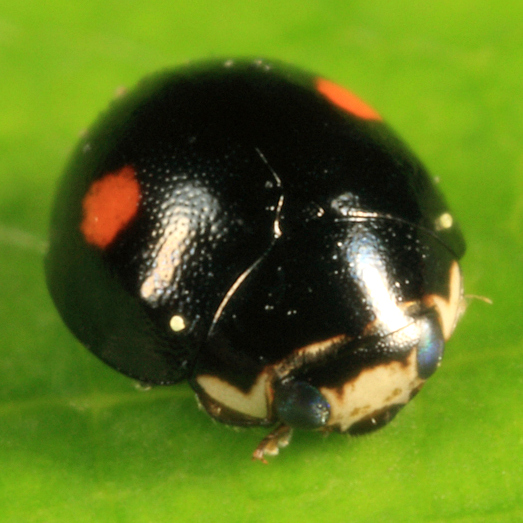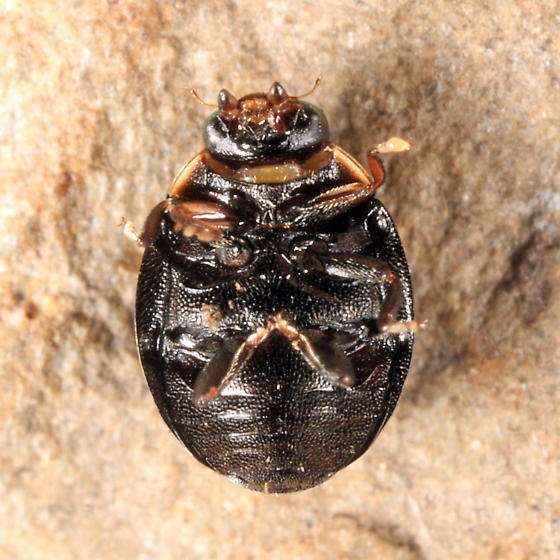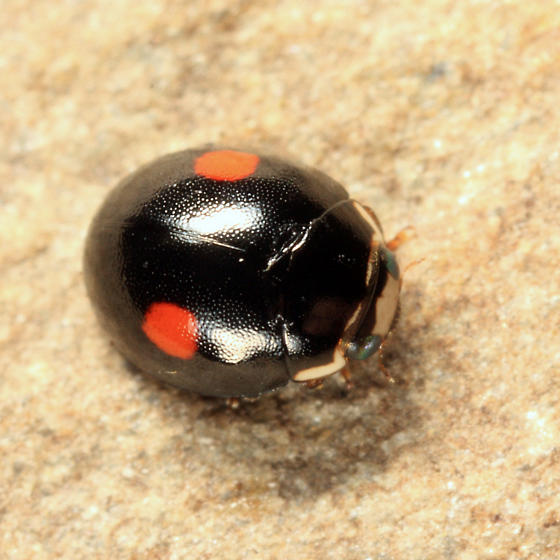Hyperaspis binotata is native to North America. Each wing cover is black with a large reddish-orange spot.
Status
Native
Ranked as “Apparently Secure” in Ontario. Hyperaspis binotata has not been ranked in the United States and does not have a global status.
Last Seen
2021
Fun Fact
Hyperaspis binotata is a widespread species, however it can be difficult to identify.
Identification
Hyperaspis binotata is 2.4 to 4.5 mm in length.
- Head: Black, with a large rectangular pale patch between the eyes that completely extends from one eye to the other.
- Pronotum: Black, with a pale margin that extends along the front of the pronotum and wraps around the sides. The pale margin is thicker on the sides of the pronotum than it is on the front of the pronotum. Females have an entirely black pronotum.
- Elytra: Black, with two red spots (one per elytron). The red spots are relatively centered on the elytra, located slightly past the centerline (closer to the posterior end of the beetle). The spots are irregularly shaped and can greatly vary in size, sometimes covering around half of the elytra. The elytra are coarsely punctured.
- Legs: Brown in color.
- Underside: The underside of the beetle is nearly entirely black.
- Often confused with: Twice-stabbed Lady Beetle.
Habitat
Arboreal, typically found in wooded ecosystems. Has also been found in meadows and gardens.
General Range
Eastern North America into southern Canada. The whole eastern coast, west to the Dakotas through Texas.
Food
Hyperaspis binotata primarily feed on wide variety of scale insects that occur on hardwoods and conifers. Hyperaspis binotata is a voracious scale insect predator, and can greatly reduce heavy scale insect infestations. Additionally, Hyperaspis binotata feeds on honeydew, aphids, aphid eggs, and mealy bugs.
Life History
Hyperaspis binotata overwinters at the base of infested trees where they feed. Beetles begin emerging from hibernation around mid-April, and disperse to look for food and breed. Eggs are typically laid in groups of around 4 on the bark of trees. Most eggs are laid between May and June, however adults will continue to sporadically lay eggs until September. Adult beetles will consume their own eggs if food is scarce. Eggs hatch after 6 to 8 days, and larvae begin to pupate between 17 and 23 days after hatching. The pupal stage lasts for 10 to 13 days, after which the adults begin to emerge. Hyperaspis binotata can be found with relative consistency from April through September.
More Information
You can find more information about Hyperaspis binotata using the following links:
Vermont Distribution
Visit the iNaturalist Observation Map and Occurrence Records to find out where Hyperaspis binotata has been seen in Vermont.









